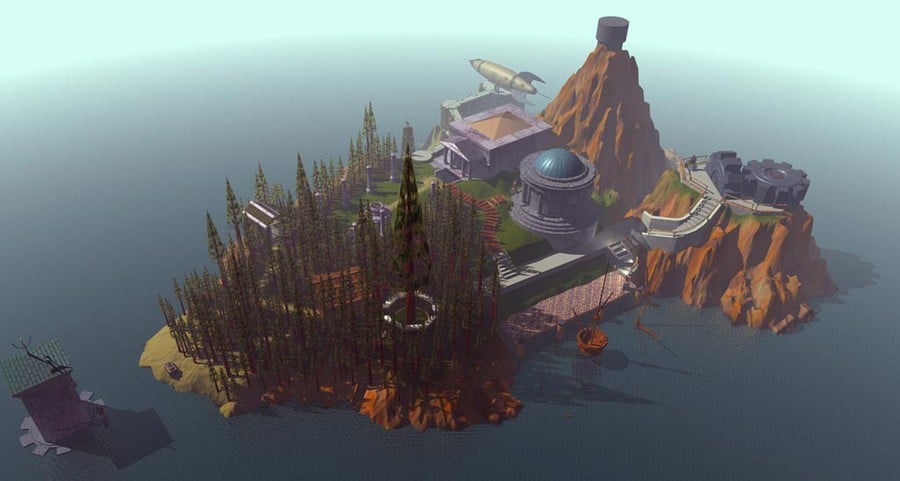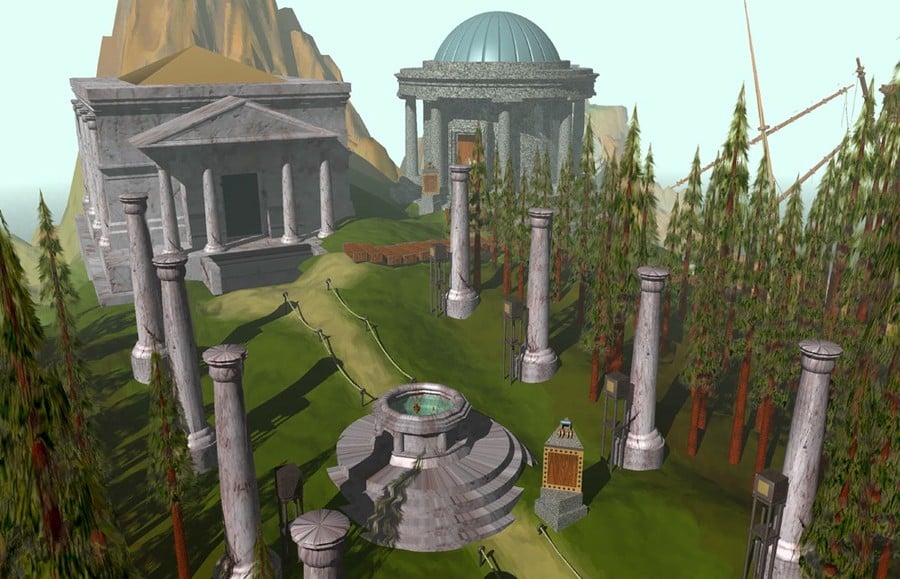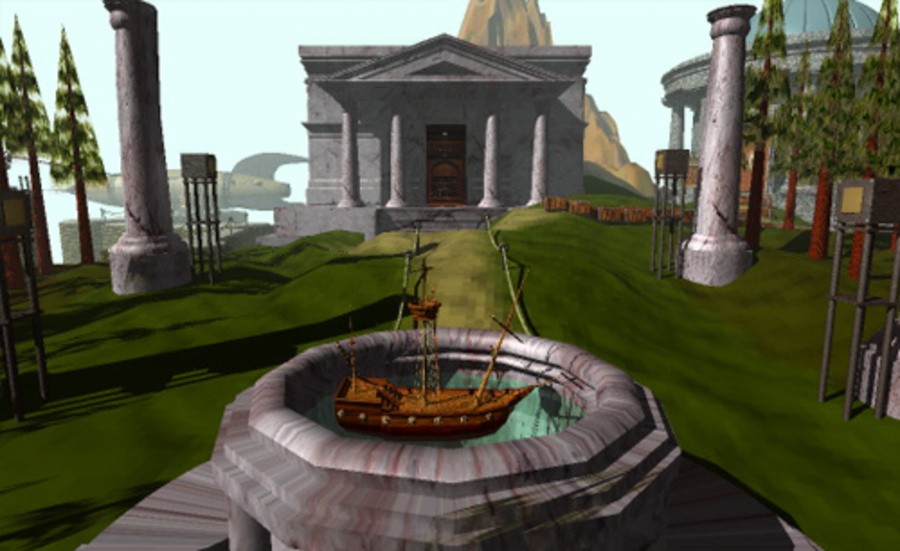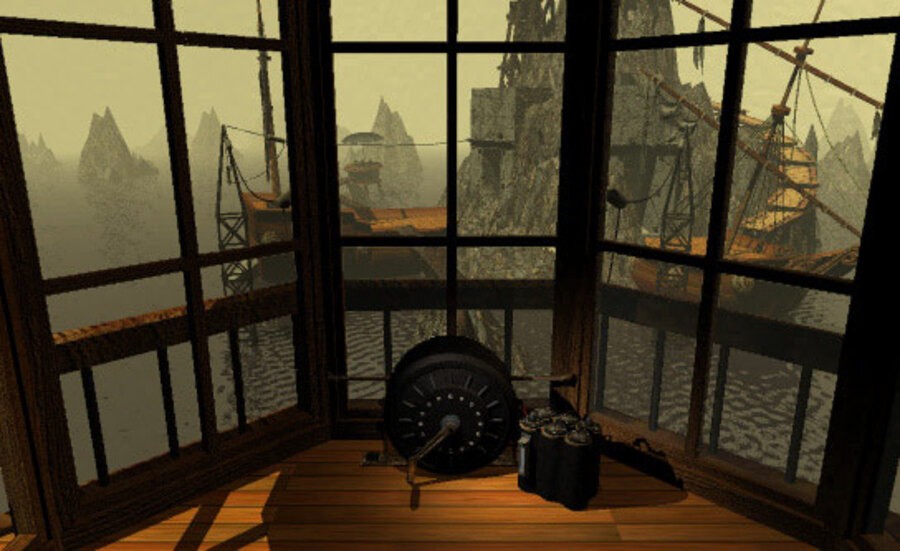
Few video games have the ability to polarise opinion quite as sharply as Myst. When it hit shop shelves back in 1993 many critics scoffed at the sedate gameplay and predicted that few people would want to sit through a game that was little more than an ‘interactive picture-postcard’. However, the general public clearly didn't share the same viewpoint. Myst captured the imagination of millions of gamers and for almost a decade was officially the best selling PC title of all time – clearly, as a slice of entertainment it did something right, regardless of the harsh critical reception it received from some sectors of the specialist press.
The brainchild of brothers Rand and Robyn Miller, Myst is undoubtedly the most famous project to emerge from the sibling’s Cyan studio (now known as Cyan Worlds) and famously encouraged hordes of non-gamers to shut down their boring old spreadsheets and use their PCs for something more pleasurable. However, in the beginning the pair didn't intend to produce games for adults. “Rand had an idea for a children’s book on a computer,” explains Robyn Miller when asked how the duo got into creating video games. “A child would turn the page, click on items on each page, and those items would react in certain ways.” The intuitive interface that would grace Myst can trace its origin to this moment. Intrigued by the notion of interactive storytelling, Robyn added his own spin on the concept and proceeded to augment his brother’s idea. “Rand sent me a copy of HyperCard, which was like a predecessor to the web,” he recalls. “The first drawing I did was of a manhole against a solid white background. But what became immediately obvious was that an entire world existed below that manhole, and I wanted to visit it. So I began to draw it and piece it together. The idea of the book altogether went out the window, or at least it quickly evolved into this idea of a more non-linear world. It was very exciting; I began moving my way through that world, making it all up as I went along.”
Subscribe to Nintendo Life on YouTube841k
"It was very exciting; I began moving my way through that world, making it all up as I went along."
This nugget of an idea became Cyan’s first game, fittingly entitled The Manhole. It offered the pair of game-design rookies an opportunity to find their footing in an exciting new industry. “I had very little idea what I was doing in terms of programming,” admits Robyn. “But Rand and I made a perfect team. I’d mail floppy disk after floppy disk to Rand, who was living on the opposite side of the country. He made the thing run smoother, faster, and smaller, and then he’d finish it off with sounds and voices.” When the pair were satisfied they had a product worth selling, they distributed The Manhole via a mail order system whilst actively courting other publishers in order to secure a more financially lucrative deal. “We printed up a few hundred copies and brought them to an industry show,” says Robyn. “People seemed to really enjoy walking around a little world which, at that time, was unique. We met a lot of companies interested in the product, but we ended up going with Activision.”
The Manhole was released on CD-ROM in 1989 and enjoys the distinction of being the first computer (but not console) game to be distributed on the format. However, the CD-ROM medium was merely used as a convenient way to store the multiple floppy discs that housed The Manhole’s code, and it wasn't until Cyan released the quirky Sci-Fi adventure Cosmic Osmo and the Worlds Beyond the Mackerel that the Miller brothers truly exploited the vast potential of the technology. “We didn't have fun with CD-ROM until Cosmic Osmo,” says Robyn. “That’s when we took advantage of all that space; not just with the music, but with the size of the world.”

With two successful children’s games under their belts the Miller brothers started to consider broadening their horizons a little – a move which surprisingly wasn't met with encouragement from all quarters. “We had proposed a Myst-like game to Activision early on, but they rejected it and told us to stick to children’s games,” laments Robyn. “It was our Japanese publisher, Sunsoft, who approached us out of the blue asking us if we’d do a game for an older audience. We shared a tremendous amount of mutual respect toward one another and we were given total creative freedom on the project. That’s virtually unheard of. It came at the perfect time; the technology was right and our ideas had matured, and that’s when we started Myst.” Ironically, as part of the deal Sunsoft only wanted the home console distribution rights – an indication of how insignificant the PC gaming market was at the time. It was a decision that would later come to haunt the Japanese company.
With vital financial support in place, work on the new title began in earnest. “In the beginning it was just me and Rand,” explains Robyn. “We did a lot of intense planning and mapped the whole thing out. It was a blast to be working on something that required a strict logic but also a history and an aesthetic sensibility. This felt more like a real world, whereas our previous products had felt like expanded playthings. It was far from perfect, but we did our best in those planning stages and had a lot of fun.” As productive as this working environment might have been, the pair knew that they would have to enlist the assistance of others to tackle such an ambitious assignment. “After we designed the ideas behind the game the production began, which took about two years,” continues Robyn. “About five people were involved in the process. Besides Rand, I worked most closely with Chuck Carter, an extremely talented artist, Chris Brandkamp who did sound design and Richard Watson who helped Rand with HyperCard scripting.” The use of HyperCard would ultimately dictate the production of the game. Although Myst would go on to enjoy incredible success on the PC, it was actually coded on the Apple Macintosh. “HyperCard only existed on Mac,” explains Robyn. “Without HyperCard, I'm certain we would have never made Myst.”
"HyperCard only existed on Mac. Without HyperCard, I'm certain we would have never made Myst"
It’s common for game developers to cite other classic video game titles as inspirations for their work, but for the Miller brothers their influences were more deep-rooted. “There was no single thing we were inspired by,” reveals Robyn. “Looking back, I’m sure that some of the inspirations came from my own school years and childhood. For example, during high school, I used to paint these large scale canvases; I’d spend hours every day on them. They were surreal things, like glimpses into some bizarre universe. I'm sure my childhood fascination with these surrealistic visions influenced the visuals throughout the Myst world. There were more direct influences, like some of the 19th century novels I was reading at the time.” Indeed, Jules Verne’s 1874 book The Mysterious Island is cited as a major inspiration for both the game’s setting, and its title.
One of the most distinctive features of Myst is the ‘Ages’ which constitute the various self-contained levels of the game. “We came up with overarching themes,” Robyn says when asked about how the team dreamt up these fantastical environments. “An example is the Selenitic Age, where all the puzzles are based on sound or music. I can’t say some external thing inspired us; we just racked our brains until we came up with the idea. That’s how we worked our way through each of the Ages. There were specific inspirations – probably too many to list – but we mostly searched for themes. When designing the puzzles and working our way through a particular age, Rand and I always reminded one another of a credo: ‘There’s always a better idea.’ We had to remain flexible and open enough to throw away any idea we’d come up with, knowing that we’d always be able to come up with something better – something more ‘right’ for the task at hand.”

One aspect of the game that is unfairly ignored by critics is the ground-breaking ‘transparent’ user interface. “We actually worked hard to create a UI that was invisible, something that didn't feel like a computer at all,” explains Robyn. ”At the time Rand and I were reading a number of books dealing with the subject of user interface as it related to the common objects that we often take for granted, like doors, switches, teapots, forks, knives, and everything else that’s designed. We were inspired by this notion of UI in the world around us, but mostly by the idea that anyone could conceivably sit down and play a virtual world, with no instructions, no introduction.” Indeed, it was this facet of the game that arguably allowed Myst to captivate so many ‘non-gamers’, as Robyn explains: “We imagined a computer illiterate user – and we often thought of our grandmother – or we imagined the type of user that doesn't have the time to learn how to play a game; these were the users that would have to be immediately drawn into a game. We wanted to create an interface that would appeal to this type of user.”
With the visuals elements of the game quickly falling into place, the team began work on the aural side of things. Chris Brandkamp handled the distinctive sound effects superbly, but it was Robyn who composed the wonderful music used in the game. Surprisingly, he’s highly critical of it. “To this day, I'm still not convinced that Myst required music,” he says. "Our philosophy was that we were creating a world. We wanted that world to be as real and believable as possible. When we’re living our daily lives we don’t hear a soundtrack of music. Instead we hear environmental sounds and sometimes these kinds of sounds have a real power to provoke mood. Think of water against a shore, birds in the trees or maybe a churn of motors inside a factory; it can be considered music of a sort. I actually think sound effects can be even more powerful in a game because it’s a simulation of a non-linear environment. You’re supposed to believe in this place. I never really had the luxury of experimenting with sounds in that way, so we had rely on music to create our mood. I still wonder if what we did was second best. Ideally speaking, the music should harmoniously coexist with the visuals, the player’s actions, the sound effects, the gameplay and the story. These elements should be an inextricable whole, continually bolstering one another, never interrupting one another. That’s the job of a director. As a director, I was unhappy with the way the Myst music stood out and felt divorced from the player’s non-linear experience. I also have a confession: I'm not a real composer and I sort of faked my way through the entire thing.” Fans of the game clearly did not share Robyn’s view and due to public demand an official soundtrack was released on CD in 1998. However, despite the praise-worthy nature of the music, Robyn was adamant that he wasn't going to make the same mistake twice. “With the sequel Riven I made an effort to push the music back into the environment,” he says. “In some cases, the soundtrack became something more like tonal sound effects. As a composer, I enjoyed writing the more obvious linear pieces, but I felt Riven required those less obvious pieces.”
"I have a confession: I'm not a real composer and I sort of faked my way through the entire thing"
It simply wouldn't be sporting to chat with one half of Myst’s creative team without touching upon the subject of the fiendish puzzles that have kept players glued to their monitors all these years. How did the duo approach the design of these brain-teasers? “Carefully - and always thinking of the user,” replies Robyn. “How would we approach this puzzle if we were playing the game? How would a new user approach the puzzle? Was it is too difficult, or too easy? We felt our best puzzles in Myst were those that weren't arbitrarily tacked onto the story and the environment, like the maze car. Our best puzzles were those that felt cohesively bonded to their surroundings, and didn't really feel like puzzles at all.”
The captivating storyline was also a key factor in Myst’s appeal. Placing the player in the shoes of a voiceless character known only as ‘The Stranger’, the game showcases a plot that focuses on two nefarious brothers (played by Rand and Robyn) attempting to undo their father’s work. Despite the rather ominous overtones, Myst is notable for its complete lack of violence. Over time many people have assumed this to be due to the Miller brothers’ strict religious upbringing as sons of a Church Minster, but Robyn maintains it wasn't as overtly intentional as that. “It’s not because Rand and I were on a campaign to stop violence in games” he confirms. “We were just out to make interesting, intriguing games. I think Rand would agree with me that violent imagery in art, film, games, or any other kind of story can be shocking in a way that can be considered good. Jarring, violent imagery is sometimes the only thing that kicks us in the ass and wakes us up to something we’d never otherwise consider. That’s what art in general is supposed to do – show us a new way of looking at the world around us. But what doesn't make sense to me is when we turn that shocking sort of violence into fun, like shoot ‘em up titles. They cause us to participate and sometimes even laugh at acts of violence. I can’t agree with that. It seems as if we are ripping away some small piece of ourselves. It doesn't make sense to me.”

Released only a few months after fellow CD-ROM starlet The 7th Guest, it’s been argued that Myst helped rapidly accelerate the PC-owning public’s uptake of CD-ROM drives and could even be described as the ‘killer app’ that sold the medium to the gaming world. “Not a lot of people had the hardware for CD-ROMs back then,” recalls Robyn. “I don’t remember being concerned about this when we shipped Myst, maybe because we never expected it to sell like it did. But suddenly, almost overnight, people began buying CD-ROM drives like crazy. It was one of those sudden sea changes, and we were caught right up on the cusp of it.” However, Robyn is quick to downplay the perceived significance of the game. “I don’t think Myst was responsible for that change, but I do think it was something that represented that change. And that whole ‘Miller Brothers’ thing represented some of that. That’s one of those things about being in a place at the right time.” This overnight success meant that the siblings were quickly heralded as poster boys for a new generation of game designers and even appeared in a Gap clothing commercial – an event that still puzzles Robyn to this day: “It was downright weird; like I was outside myself, watching this bizarre phenomenon taking place.”
"Myst may have seemed almost too simple to gamers who were used to things that looked and felt like games"
The healthy sales of the game (6 million copies sold to this day, and counting) proved one thing – the general public adored it. However, many sectors of the gaming community were quick to turn their noses up at what they perceived to be a boring flick-screen puzzle game with no blood or gore (it’s important to remember that id Software subjected the PC gaming world to the visceral delights of Doom just a few months after the launch of Myst). Unsurprisingly, a negative critical reaction occurred, with several magazines granting Myst decidedly icy reviews. For once, the specialist press seemed hopelessly out of touch with the common gamer – but the response didn't surprise Robyn. “I think there was stuff that frustrated practised gamers. There were no command keys, there was only the mouse and one button, there was no avatar, the world was presented cinematically, and so on,” he explains. “Because of all this, Myst may have seemed almost too simple to gamers who were used to things that looked and felt like games. And yet this is partly what made Myst so popular with the majority of our audience - those who’d never played a game before. To them, Myst was approachable; it felt real.”
Although his brother Rand still heads Cyan Worlds, Robyn decided to part company after completing work on Riven in 1997 and now runs his own film production studio, known as Land of Point, as well as indulging his musical side as part of a group called Ambo. Although he’s turned his back on the video game industry for the time being, he’s still visibly thrilled by the astonishing success that has Myst enjoyed. “Creating a world from that blank slate – it was a rare and wonderful opportunity,” he says with a smile. “But like I said, we never could have foreseen the overwhelming response. It blew us away. Thanks a ton to everybody who ever played Myst. Thank you all, sincerely!”
This feature was originally printed in its entirety in Retro Gamer magazine, and is reproduced here with kind permission.





Comments 19
Now I really want to play this.
I love the "early good pc graphics" and the overall graphical style this game uses.
I will try to get the 3ds version or download it some day.
I wouldn't bother Morphtroid the game is meant to suck
I don't care what the haters say, this game was great fun. I wouldn't probably have liked it as much if GameFaqs had not existed when I played it first, though.
I found it to be slow and tedious, the music and sound effects were iffy, and the pace of the, for want of a better word, gameplay will try its best to keep you gripped but bless it, it fails but don't get me wrong, it's ok. I'm not sure if the majority of modern day gamers will have the patience for this. It has a cult following and it's by no means the worst game ever but to those tempted by it, read everything and watch everything about it first. This really needs an eShop demo.
From what I understand, the 3DS version is a straight port of the earlier DS release. The Nintendo.com page for it tries to sell it as a port of RealMYST (the actual rendered-in-polygons version), but that's a lie.
You can get it for $6 on GOG.com
@Morphtroid The 3DS version is excruciating to play. Seriously, get it on another platform.
@MadAussieBloke Yes, yes, and yes.
I'd have to learn more about the 3DS version compared to the others before I made a decision.
This is the first game I've seen get butchered on the eShop. Last I checked (Thursday) it had about 2 stars with about 10 reviews. (US eShop)
It sounds like it might be interesting, but I have other things that I'm looking to buy right now, so I'll have to say no.
When I was younger, I loved Myst just for walking around a playing pretend. Now, I play it how it's meant to be played. Sadly, though, I used walkthroughs for Myst, Riven, and Myst III, and some of Myst IV and V. Now, I'm trying to beat Myst IV and V without using walkthroughs.
One thing that I wonder why they haven't done is re-create the game. I know they made RealMyst, but that was a long time ago. The need to re-make Myst in graphics like Myst IV. Those graphics are absolutely incredible.
I never played this so might get it on the 3DS.
That Gap anecdote is bizarre...
The 3DS version is a bad port of a bad port.
Considering how important Myst is to the industry it is strange that Cyan and Sunsoft keep letting an untalented team port it on Nintendo handhelds.
I've never heard of this until just now. Apparently this is a famous game? And it's on the eShop? Didn't even see it on the eShop but okay.
Anybody who thinks Myst sucks hasn't played RealMyst on a PC that can handle it.
When Myst came out it used an "interactive picture book" design because PCs of the time had no 3D acceleration and certainly couldn't produce scenes as rich and detailed as can be seen in the still images of Myst. They exploited the brand-new CD-ROM technology with its huge amount of storage to make a game that couldn't have been made before. However, people scoffed because even though the images looked great, they were static.
So, what did Cyan do? A few years later they set out to reproduce the same game using real-time 3D acceleration without sacrificing one ounce of detail or immersion. This was RealMyst, and unsurprisingly reviewers panned it heavily. Why? Because the computers of the time couldn't handle it. Damned if you do....
Luckily, computers now can render it the way it was intended to be seen with ease, and it looks better than many 3D games on the market today. It's amazing that in a game releasing in 2000, the water actually moves in a realistic manner. I don't mean it's flat with some ripples digitally generated using pixel shaders. That didn't exist at the time. They actually rendered multiple layers of moving water with physical geometry that moves and deforms in realtime exactly the way water should. Most games today don't bother with that level of detail.
I thought it was interesting and had a very odd/ creepy vibe to it. Probably wouldn't play it now and I know I could never beat it without some kind of guidance. haha
My bro loved this game when first released. I just found it boring, but he made his way until the end of the game.
For modern audiences, it may not seem much, but this was awesome when it appeared. Kinda like Dragon's Lair.
I am a MYST addict
I've played them all from from MYST to MYST V: End Of Ages to realMYST and even URU with it's many deaths and multiple resurrections (going so far as started early designing for a user made age).
Myst was such an awesome but hard game, I've even got a copy of Riven that I got from an Op Shop for $5, its in near perfect condition & doesn't even look like the CDs were even used. Too bad I haven't been able to get it going on my laptop, I'll figure it out one day. Thank you Miller Brothers for creating an amazingly innovative series that still holds up even to this day
Show Comments
Leave A Comment
Hold on there, you need to login to post a comment...